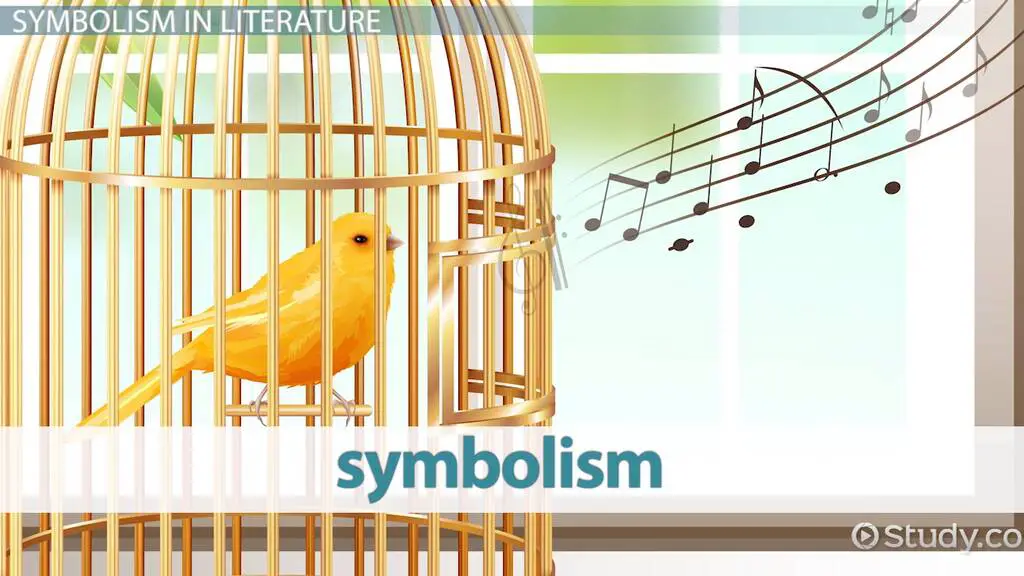Symbols in I Know Why the Caged Bird Sings represent freedom and resilience, illustrating the protagonist’s journey of self-discovery and overcoming adversity. This essay explores the significance of these symbols and how they contribute to the overall themes of the novel.
In Maya Angelou’s memoir, I Know Why the Caged Bird Sings, symbols play a crucial role in conveying the book’s themes of freedom and resilience. Through the use of symbols such as the caged bird, the cotton fields, and the human voice, Angelou paints a vivid picture of the African American experience during the Jim Crow era.
These symbols not only represent the struggles of the characters, but also highlight their ability to rise above oppression and find strength in the face of adversity. By examining the symbolism in I Know Why the Caged Bird Sings, readers gain a deeper understanding of the book’s central themes and the power of the human spirit.
The Symbolism Of The Caged Bird
In “I Know Why the Caged Bird Sings,” the caged bird symbolizes the confinement and oppression experienced by African Americans. Through this metaphor, Maya Angelou depicts the struggle for freedom and equality. The bird’s yearning for liberation represents the resilience and indomitable spirit of the human soul.
Maya Angelou’s Use Of The Caged Bird
Maya Angelou’s renowned memoir, I Know Why the Caged Bird Sings, utilizes the symbol of the caged bird to convey profound themes of oppression, resilience, and the longing for freedom. Through her powerful storytelling style, Angelou captures the reader’s attention and leaves an indelible impact.
The Significance Of The Caged Bird
The caged bird symbolizes the Black experience in America during a time of rigid racial segregation and discrimination. Through this symbol, Angelou explores the feelings of confinement, yearning, and hope embedded within the human spirit, regardless of race or background.
Angelou’s use of the caged bird metaphor is not only poignant but also thought-provoking. By contrasting the bird’s physical constraint with its innate desire to fly freely, Angelou underscores the universal human yearning for autonomy and self-expression. This juxtaposition draws attention to the oppressive circumstances faced by African Americans in the United States.
Furthermore, the caged bird allegory serves as a reminder of the resilience and inner strength that can emerge in the face of adversity. Just as the caged bird sings, Angelou suggests that even amidst the harshest conditions, individuals can find solace and empowerment through their own voices and personal narratives.
The symbolism of the caged bird in Angelou’s memoir transcends the boundaries of race and appeals to our collective humanity. It serves as a testament to the triumph of the human spirit and the enduring pursuit of freedom and equality.

Credit: en.wikipedia.org
Impact Of Racism And Oppression
Symbols in “I Know Why the Caged Bird Sings” illustrate the profound impact of racism and oppression. These symbols vividly convey the struggle and resilience of the marginalized, painting a vivid picture of the injustices they face. From the bird trapped in its cage to the towering walls of racial discrimination, the symbols expose the pain and triumph of the human spirit.
Symbolism Of The Caged Bird In Relation To Racism
Racism is a prevailing theme in Maya Angelou’s memoir, I Know Why the Caged Bird Sings. Through the powerful symbolism of the caged bird, Angelou effectively portrays the impact of racism on the lives of African Americans during the era of segregation.
The caged bird serves as a metaphor for the oppression and confinement experienced by African Americans as a result of racial discrimination. Just as the caged bird is unable to fly freely, African Americans were deprived of their basic rights and freedoms due to the color of their skin.
The bird’s “bars of rage” symbolize the deep-seated anger and frustration felt by those who were subjected to racial injustice and prejudice. Despite their desire for freedom, they were constantly held back by the oppressive system of racism that restricted their opportunities for growth and advancement.
This symbolism highlights the inhumanity of racism and underscores the resiliency and strength displayed by African Americans in the face of adversity. Much like the bird, they refused to succumb to the limitations imposed upon them, fighting for equality and justice.
Linking The Caged Bird To Oppression
Aside from representing racism, the caged bird also serves as a powerful symbol of oppression. Just as the bird is confined within the cage, African Americans were often trapped in a cycle of poverty, discrimination, and limited opportunities.
The bird’s song, described as “a fearful trill,” echoes the muted voices of African Americans silenced by the oppressive forces of society. Their struggles and experiences were often ignored or dismissed, with their voices drowned out by the prevailing racism and discrimination of the time.
By linking the caged bird to oppression, Angelou exposes the detrimental effects of a society that seeks to stifle the voices and aspirations of a particular group. The symbolism evokes empathy and encourages readers to reflect on the gravity of oppression and the urgent need for change.
In conclusion, the symbolic use of the caged bird in I Know Why the Caged Bird Sings vividly highlights the impact of racism and oppression on African Americans. Through this powerful imagery, Maya Angelou effectively conveys the hardships faced by her community while also emphasizing their resilience and determination in the face of adversity.
Freedom And Resilience
In Maya Angelou’s “I Know Why the Caged Bird Sings,” symbols play a significant role in conveying the themes of freedom and resilience. The caged bird, in particular, serves as a powerful emblem of both the longing for freedom and the ability to endure adversity with strength and determination.
Symbolic Representation Of Freedom In The Book
Throughout the book, the concept of freedom is symbolically represented through various characters and events. For instance, the protagonist, Maya, yearns for the freedom to express herself and break free from the societal constraints that seek to confine her. The setting of the book itself, the segregated South in the 1930s, serves as a symbol of the lack of freedom for African Americans during that time.
The Caged Bird As A Symbol Of Resilience
The caged bird in the title is a poignant symbol of resilience, representing the ability to maintain hope and strength in the face of adversity. The bird’s steadfast singing, despite being confined, reflects the resilience of the human spirit in the toughest of circumstances. Just as the caged bird refuses to be silenced, the characters in the book exhibit resilience in overcoming the challenges that threaten to constrain their lives.
Metaphorical Imagery In The Text
Metaphorical Imagery in the Text: The use of metaphorical imagery in “I Know Why the Caged Bird Sings” by Maya Angelou adds depth and complexity to the narrative. Through powerful symbols, Angelou effectively conveys themes of oppression, resilience, and freedom.
Analysis Of Other Symbols In The Book
1. The Caged Bird: Symbolizes the imprisonment and struggles faced by the African American community during segregation.
2. The Store: Represents the escape and solace that literature and education provide for the main character, Maya.
How Symbolism Enhances The Reader’s Experience
- Engagement: Symbols create a deeper connection between the reader and the characters, evoking empathy and understanding.
- Emotional Impact: Symbolism elicits powerful emotions in the reader, enhancing the overall reading experience.
- Themes Reinforcement: Symbols reinforce the central themes of the story, allowing readers to delve into the underlying messages.
Continued Relevance And Interpretation
Understanding symbols in Maya Angelou’s I Know Why the Caged Bird Sings is essential for grasping its Continued Relevance and Interpretation.
The Enduring Power Of Symbolism In Literature
Symbols in literature resonate across generations due to their universal meanings and timeless appeal.
Interpreting The Symbolism In Today’s Context
Interpreting symbols from the past can provide insight into contemporary issues and emotions.

Credit: study.com

Credit: en.wikipedia.org
Frequently Asked Questions On Symbols In I Know Why The Caged Bird Sings
What Does The Train Symbolize In I Know Why The Caged Bird Sings?
The train symbolizes both escape and progress in “I Know Why the Caged Bird Sings. ” It represents Maya’s desire to leave her oppressive surroundings and pursue her dreams. The train also symbolizes societal changes as African Americans move towards freedom and equality.
What Does The Free Bird Symbolize In Caged Bird?
The free bird symbolizes freedom, joy, and opportunities in “Caged Bird” by Maya Angelou. It contrasts the caged bird’s oppression and conveys the longing for liberty. The free bird represents the desire for emancipation and the yearning to break free from limitations.
What Is The Caged Bird A Symbol Of And The Song The Bird Sings A Symbol Of In The Poem Caged Bird By Maya?
The caged bird symbolizes oppression, while the song it sings symbolizes resilience and the yearning for freedom in Maya Angelou’s poem.
What Does The Cage Represent In The Poem I Know Why The Caged Bird Sings By Maya Angelou?
The cage in the poem “I Know Why the Caged Bird Sings” represents the oppression and limitations of the African American experience. It symbolizes the struggle for freedom and the desire to break free from societal constraints. Maya Angelou uses the imagery to convey the longing for equality and justice.
Conclusion
In Maya Angelou’s “I Know Why the Caged Bird Sings,” symbols like the caged bird and the African American experience resonate deeply. They serve as powerful metaphors for oppression and resilience. By understanding these symbols, readers can gain a deeper appreciation for the book’s themes and the struggles faced by the author and her community.








